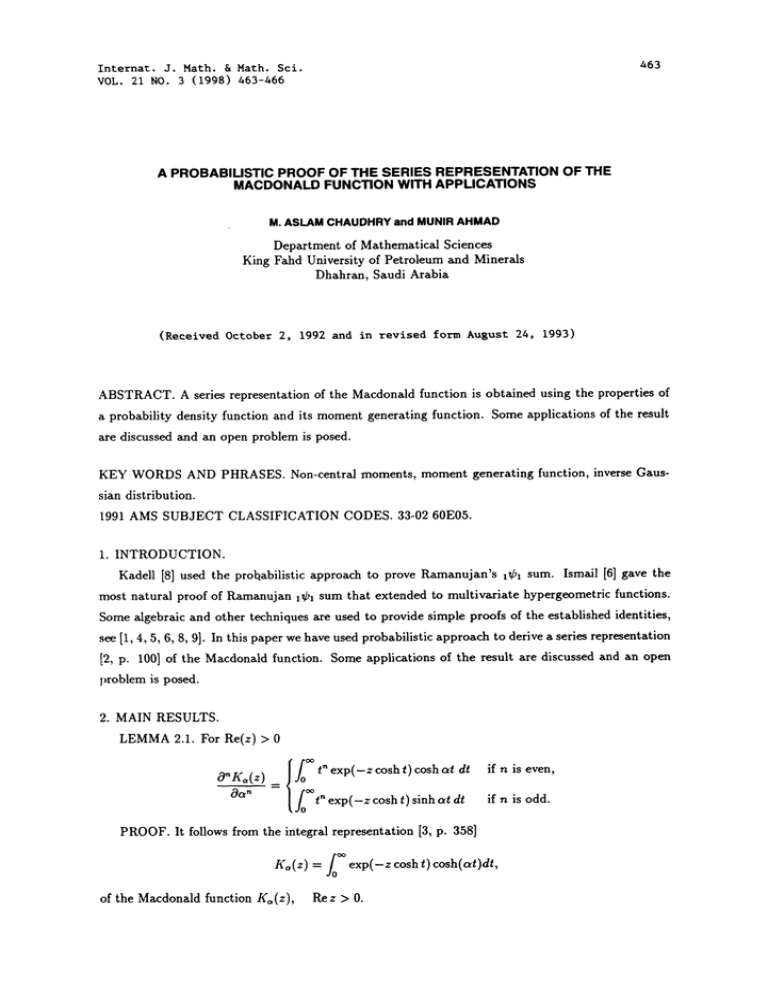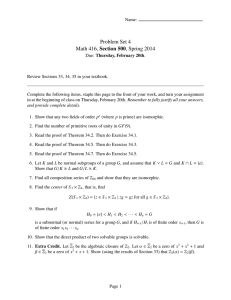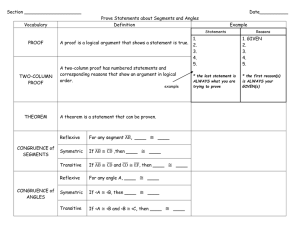REPRESENTATION THE
advertisement

463
Internat. J. Math. & Math. Sci.
VOL. 21 NO. 3 (1998) 463-466
A PROBABILISTIC PROOF OF THE SERIES REPRESENTATION OF THE
MACDONALD FUNCTION WITH APPLICATIONS
M. ASLAM CHAUDHRY and MUNIR AHMAD
Department of Mathematical Sciences
King Fahd University of Petroleum and Minerals
Dhahran, Saudi Arabia
(Received October 2, 1992 and in revised form August 24, 1993)
ABSTRACT. A series representation of the Macdonald function is obtained using the properties of
a probability density function and its moment generating function. Some applications of the result
are discussed and an open
problem is posed.
KEY WORDS AND PHRASES. Non-central moments, moment generating function, inverse Gaussian distribution.
1991 AMS SUBJECT CLASSIFICATION CODES. 33-02 60E05.
1.
INTRODUCTION.
Kadell
[S] used the prohabilistic approach
to prove Ramanujan’s
,,
sum. Ismail
[6] gave the
extended to multivariate hypergeometric functions.
Some algebraic and other techniques are used to provide simple proofs of the established identities,
see [1, 4, 5, 6, 8, 9]. In this paper we have used probabilistic approach to derive a series representation
[2, p. 100] of the Macdonald function. Some applications of the result are discussed and an open
most natural proof of Ramanujan
1bl
sum that
9[o
tn exp(-z cosh t) cosh ct dt
problem is posed.
2. MAIN RESULTS.
LEMMA 2.1. For Re(z) > 0
i:T’Ko(z)
0c"
f0ot exp(-z
cosh t) sinh at dt
if n is even,
if n is odd.
PROOF. It follows from the integral representation [3, p. 358]
K,(z)
of the Macdonald function Ko(z),
exp(-z osh t)cosh(at)dt,
Re z > 0.
M.A. CHAUDHRY AND M. AHMAD
464
THEOREM 2.1. Let 0 < < and Re z > 0. Then,
Ko(2zv/ t) (1 t) ’/2
-
PROOF. Let us define the function I(c,/) by
I(, )
Then, the function defined by
-
-)e,
xp(-
,
<,<
(I(o,))-lz t’-’ exp(-z Bz-’),
f(z)
(2.1)
K,,,,(2z)(zt)’/r!
r----O
0 of theorem 1.11 in
(2.3) has appeared in
(2.3) as
I(a + r, fl)
I(oe,)
x" f(x)dx
an
[7].
The r-th non-central moment of the random variable X having
E(X )
(2.3)
> O, /> 0
z
is the probability density function (pdf). It may be noted that the pdf
earlier work. This is the limiting case a
(2.2)
> 0.
its pdf is given by
(2.4)
The moment generating function (mgf) of f(x) is given by
E(et)
Substituting (1
etf(x)dx
t)x
v in
x -’ exp(-(1
I(o, )
t)x x-)dx,
0
_< <
1.
(2.5)
(2.5) and simplifying we get
E(et:)
I(a, B(1 t))
(1 t)’I(a,)"
(2.6)
The relation
S(et)=_,S(X’).
r--O
yields,
I(a,(1 t))
(1-t)’I(a,B)
,.=o
I(( + r,f) t"
I(a,) r!
or
I( + r,f) (1
I(a,(1 t))
It is known [3, p. 340] that
l(c, )
From (2.7) and (2.8)
we
2/2K(2V/r),
get
K(2/fl(1 -t))
-,
(1 t) ’#
r----O
The substitution
In particular when
z in
t)
.
(2.7)
Re > 0.
(2.s)
f’/Ko+,(2f).
(2.9)
<a < c,
(2.9) yields the proof of the theorem.
z in (2.9) we get
0 and
K0(2z/il -t))
_,
{z"K,.,(2z)}
n’
(2.10)
SERIES REPRESENTATION OF THE MACDONALD FUNCTION
which shows that
Ko(zlv/’i-X-t)
is the generating function of
465
.(z/2)’Kn(z),
n
0,1,2,3,....
An immediate consequence of the theorem is the following result which provides the closed form
solution to the representation of the first derivative with respect to the order of the Macdonald
function at the integral values of the order. The problem remains open for the higher derivatives and
the other values of the order of the function.
COROLLARY 2.1. For Re(z) > 0,
1 n!
2 z
0
Oa [K,(2z)la=n
(z)"-K,_j(2z)
j(n
j)’
PROOF. Differentiating both sides of (2.1) with rpect to a
0 [(]
(
)z
0
N {g,,()} +
we
get
(.)
)I(,,()
1(
However, it follows from the lena that
0
Therefore, substituting
get
0
0 in
0.
-
(.
(2.10) and using the series reprentation of ln(1 ) d (2.11)
[g+(z)]=o
=0
[g(ll.
(zt)r(tt+
+"" +
+
Z(2)
=0
(t)
Equating the coefficients of t" in (2.12) yields the desired proof.
COROLLARY 2.2. For Re z > 0,
I
exp(-2z sh t) sinh(nt)dt
n, z"-’K_,(2z)
3=1
j(n
j)’
PROOF. This follows from the lena and Corrollary 2.1.
In particular when n 2 we get
exp(- cosh )sinh()e
[K() + K()],
(.14)
which do not sm to be known in the literature.
We state here an open problem the solution to which will have Nr-rching eonsequenc in the
genereliation of the inverse Geussian distribution.
STATEMENT OF THE OPEN PROBLEM. Find the relationship of
Nnctions for n > 2.
with the ther
ACKNOWLEDGEMENTS. Private corrpondence with Professor M. hmen at Carleton UniversitN Ottewa, Canada is appreciate. The authors are indebted to the the refer for helpNl comments
and to the King Fahd University of Petroleum and MinerMs for the excellent research Ndlities.
M.A. CHAUDHURY AND M. AIIMAD
466
REFERENCES
I. BRESSOUD, D.M. An easy proof of the Rogers- Ramanuj an identities, J. Numb. Thy., 16(1983a),
235-241.
2.
ERDILYI, ET AL., Higher Transcendental Functions, vol.
3. GRADSHTEYN, I.S. and RYZHIK, I.M. Tables
II(McGraw-Hill, 1954).
of Integrals, Series,
and Products (Academic
Press, 1980).
4.
HIRSHHORN, M.D. A simple proof of Jacobi’s
92(1985), 579-580.
5.
HIRSHHORN, M.D. A simple proof of Jacobi’s four-square theorem, Proc. Amer. Math. Soc.
two square theorem, Amer. Math.
Monthlt
I01(1987), 436-438.
6. ISMAIL, M.E.H. A simple proof of Ramanujan’s ,b, sum, Proc. Amer. Math. Soc. 63(1977),
185-186.
7.
8.
ISMAIL, M.E.H. and KELKER, H.D. Special functions, Steiltjes transforms and infinite divisibility, SIAM J. Math. Anal. I0(1979), 884-901.
KADELL, K.W.J. A probabilistic proof of Ramanujan’s Ix sum, SIAM J. Math. Anal.
8(1987a),
9.
1539-1548.
RAHMAN, M. A simple proof of Koornwinder’s additional formula for the little q-Legendre
polynomials (to appear).






